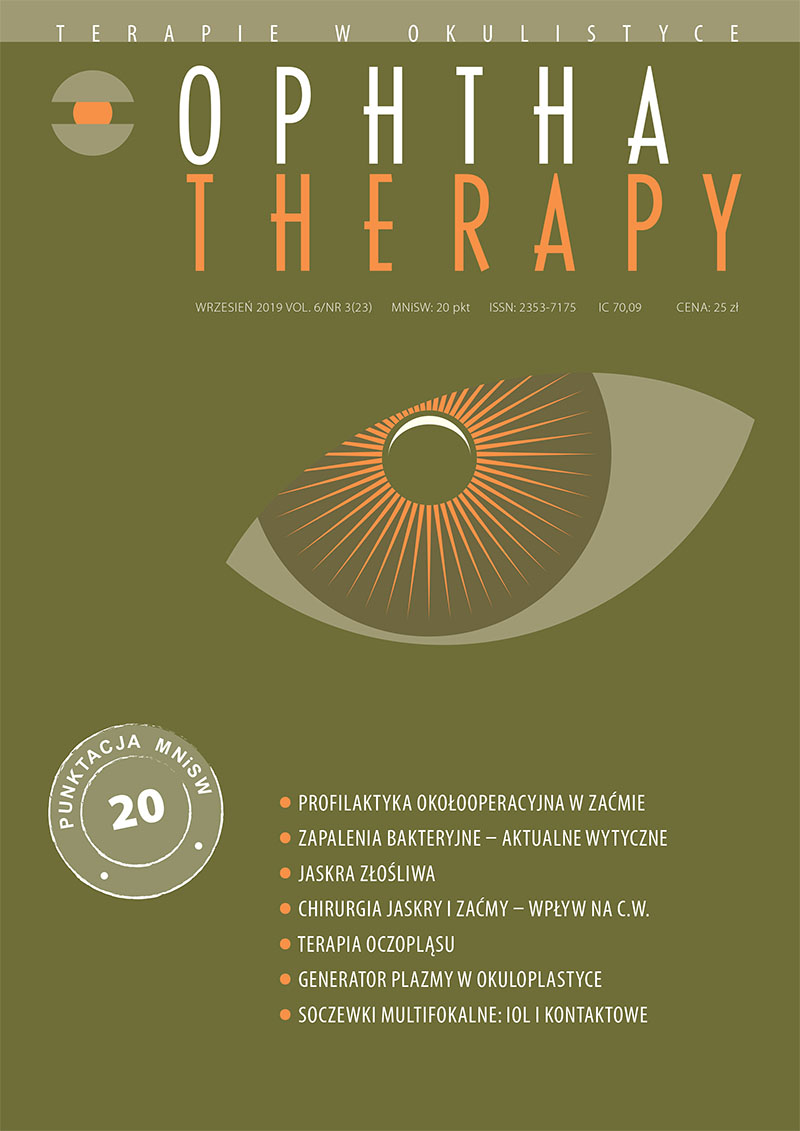Glaucoma and cataract: the effect of the phacoemulsification procedures and the combined procedures on the intraocular pressure
Main Article Content
Abstract
Glaucoma, according to the WHO, is the second most common cause of blindness after cataract. These two diseases: however, often occur together and greatly affect each other. The procedure, including the appropriate qualification, the surgery itself and post-operative care, varies depending on the disease severity, the earlier medical history and the treatment of each of these diseases. In the current society, the number of patients suffering from glaucoma and at the same time in need of the cataract surgery is increasing. Currently, the most common method of cataract removal is phacoemulsification procedure with the implantation of artificial lens. Research suggests a decrease in intraocular pressure after such surgery, which has a beneficial effect especially in patients treated for glaucoma. This effect: however, is not long-lasting, which is why the procedures combining phacoemulsification with the anti-glaucoma treatment are often used, causing a longer lasting reduction of intraocular pressure. Certainly, the final result depends on many factors, including the type of glaucoma and the selected anti-glaucoma treatment. There are many studies comparing various therapeutic approaches in the case of the coexistence of these two leading ophthalmic diseases.
Downloads
Article Details

This work is licensed under a Creative Commons Attribution-NonCommercial-NoDerivatives 4.0 International License.
Copyright: © Medical Education sp. z o.o. License allowing third parties to copy and redistribute the material in any medium or format and to remix, transform, and build upon the material, provided the original work is properly cited and states its license.
Address reprint requests to: Medical Education, Marcin Kuźma (marcin.kuzma@mededu.pl)
References
2. Masis M, Mineaut PJ, Phan E et al. The role of phacoemulsification in glaucoma therapy: a systemic review and meta-analysis. Surv Ophthalmol. 2018; 63(5): 700-10.
3. Li T, Lindsley K, Rouse B et al. Comparative Effectiveness of First-Line Medications for Primary Open-Angle Glaucoma: A Systematic Review and Network Meta-analysis. Ophthalmology. 2016; 123(1): 129-40.
4. Tabin G, Chen M, Espandar L. Cataract surgery for the developing world. Curr Opin Ophthalmol. 2008; 19(1): 55-9.
5. Mansberger SL, Gordon MO, Jampel H et al. Reduction in intraocular pressure after cataract extraction: the Ocular Hypertension Treatment Study. Ophthalmology. 2012; 119(9): 1826-31.
6. Dias-Santos A, Ferreira J, Abegão Pinto L et al. Phacoemulsification versus peripheral iridotomy in the management of chronic primary angle closure: long-term follow-up. Int Ophthalmol. 2015; 35(2): 173-8.
7. Fea AM. Phacoemulsification versus phacoemulsification with micro-bypass stent implantation in primary open-angle glaucoma: randomized double-masked clinical trial. J Cataract Refract Surg. 2010; 36(3): 407-12.
8. Gedde SJ, Singh K, Schiffman JC et al. Tube Versus Trabeculectomy Study Group. The Tube Versus Trabeculectomy Study: interpretation of results and application to clinical practice. Curr Opin Ophthalmol. 2012; 23(2): 118-26.
9. Gupta SK. Intention-to-treat concept: A review. Perspect Clin Res. 2011; 2(3): 109-12.
10. Hayashi K, Hayashi H, Nakao F et al. Effect of cataract surgery on intraocular pressure control in glaucoma patients. J Cataract Refract Surg. 2001; 27(11): 1779-86.
11. Hou X, Hu D, Cui Z et al. Small-incision phacotrabeculectomy versus phacoemulsification in refractory acute primary angle closure with cataract. BMC Ophthalmol. 2015; 15: 88.
12. Husain R, Gazzard G, Aung T et al. Initial Management of Acute Primary Angle Closure: A Randomized Trial Comparing Phacoemulsification with Laser Peripheral Iridotomy. Ophthalmology. 2012; 119(11): 2274-81.
13. Iancu R, Corbu C. Intraocular pressure after phacoemulsification in patients with uncontrolled primary open angle glaucoma. J Med Life. 2014; 7(1): 11-6.
14. Issa SA, Pacheco J, Mahmood U et al. A novel index for predicting intraocular pressure reduction following cataract surgery. Br J Ophthalmol. 2005; 89(5): 543-6.
15. Jacobi PC, Dietlein TS, Krieglstein GK. Comparative study of trabecular aspiration vs trabeculectomy in glaucoma triple procedure to treat pseudoexfoliation glaucoma. Arch Ophthalmol. 1999; 117(10): 1311-8.
16. Kashiwagi K, Kashiwagi F, Tsukahara S. Effects of small-incision phacoemulsification and intraocular lens implantation on anterior chamber depth and intraocular pressure. J Glaucoma. 2006; 15(2): 103-9.
17. Kass MA, Heuer DK, Higginbotham EJ et al. The Ocular Hypertension Treatment Study: a randomized trial determines that topical ocular hypotensive medication delays or prevents the onset of primary open angle glaucoma. Arch Ophthamol. 2002; 120(6): 701-13.
18. Kim DD, Doyle JW, Smith MF. Intraocular pressure reduction following phacoemulsification cataract extraction with posterior chamber lens implantation in glaucoma patients. Ophthalmic Surg Lasers. 1999; 30(1): 37-40.
19. Lai JSM, Tham CCY, Chan JCH. The clinical outcomes of cataract extraction by phacoemulsification in eyes with primary angle-closure glaucoma (PACG) and coexisting cataract: a prospective case series. J Glaucoma. 2006; 15(1): 47-52.
20. Baek SU, Kwon S, Park IW et al. Effect of Phacoemulsification on Intraocular Pressure in Healthy Subjects and Glaucoma Patients. J Korean Med Sci. 2019; 34(6): e47.
21. Kim WJ, Kim JM, Lee WH et al. Effect of combined goniotomy and phacoemulsification on intraocular pressure in open‐angle glaucoma patients. Clin Exp Ophthalmol. 2019: 1-9.
22. Wang N, Jia SB. Phacoemulsification with or without goniosynechialysis for angle-closure glaucoma: a global Meta-analysis based on randomized controlled trials. Int J Ophthalmol. 2019; 12(5): 826-33.
23. Hayashi K, Yoshida M, Sato T et al. Effect of Topical Hypotensive Medications for Preventing Intraocular Pressure Increase after Cataract Surgery in Eyes with Glaucoma. Am J Ophthalmol. 2019. pii: S0002 9394(19)30118-7.
24. Guan H, Mick A, Porco T et al. Preoperative factors associated with IOP reduction after cataract surgery. Optom Vis Sci. 2013; 90(2): 179-84. https://doi.org/10.1097/OPX.0b013e31827ce224.

